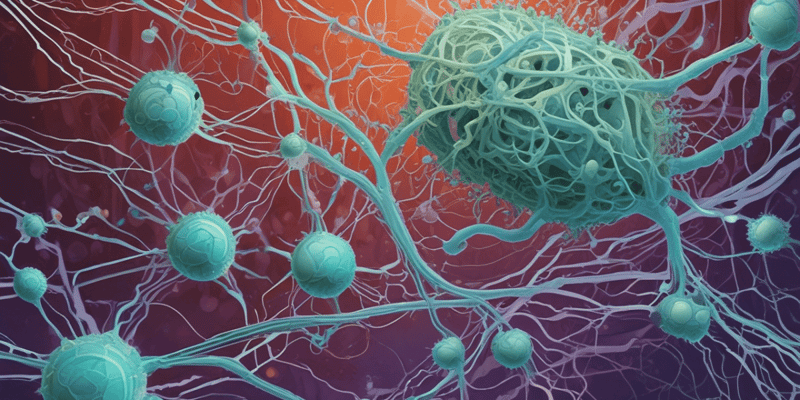28 Questions
Which of the following is a function of basal lamina?
Providing a foundation for assembling cells into tissue
In which tissues does the basal lamina surround each cell?
Muscle and fat
What is the role of the basal lamina in the development of the nervous system?
Guiding neurons along ECM pathways
How does the basal lamina contribute to the formation of a tight barrier between the blood and the brain?
By employing two distinct basal laminae
Which protein is a key component of basal laminae and is a multi-adhesive matrix protein?
Laminin
What is the major structural component of basal laminae and can bind to adhesion receptors including integrins?
Type IV collagen
What can mutations in genes for type IV collagen and laminin-5 lead to?
Alport syndrome
What do basement membranes inhibit in relation to endothelial cells?
Proliferation and migration
In tumor growth, what do inflammatory and stromal cells produce to degrade the vascular basement membrane?
Matrix metalloproteinases
How many genes in humans encode collagens?
43
What can defects in the glomerular basement membrane, composed of type IV collagen and laminin, lead to?
Renal failure
What crucial roles do the extracellular matrix and basement membranes play?
In tissue structure, function, and disease
What is essential for advancing our knowledge of developmental processes, tissue homeostasis, and disease mechanisms?
Understanding the complex interactions and functions of extracellular matrix components
What kind of protein are collagens?
Trimeric
What is a heterotrimeric protein consisting of α, ß, and γ chains?
Laminin
What kind of network does type IV collagen assemble into?
Branching, irregular two-dimensional
Which of the following is a characteristic of Alport’s syndrome?
Progressive renal failure, sensorineural hearing loss, and ocular abnormalities
What is the major component of the core protein of perlecan?
Ig domains
How do mutations in ECM component genes, such as COL1A1, affect bone formation?
Promote bone formation defects
What is the consequence of overproduction and excessive deposition of ECM?
Fibrosis
How does increased ECM stiffness promote tumor cell survival and growth?
Promotes p1-integrin clustering and PI3K signaling
What is the role of protease inhibitors in breast cancer prognosis?
Correlates with good prognosis
What is the function of tenascin C within the ECM in pancreatic cancer?
Promotes cancer cell survival and proliferation
How does ECM composition control migration of immune cells and tumor cells?
Loose ECM areas facilitate cell motility, whereas dense ECM areas impede migration
What do fibrotic ECM stimulate fibroblasts to do?
Increase ECM production
What is a potential therapeutic strategy for targeting disease-associated ECM molecules?
Interference with the hyaluronic acid/CD44 signaling pathway
How does ECM serve as a reservoir for growth factors?
Release due to ECM remolding
What is a potential benefit of normalizing vasculature through modulating ECM?
Improving anticancer drug distribution
Study Notes
Extracellular Matrix Components and Basement Membranes: Key Structures and Functions
- Components of the basal lamina include type IV collagen, laminins, perlecan, and nidogen
- Laminin is a key component of basal laminae and is a multi-adhesive matrix protein
- Laminin is a heterotrimeric protein consisting of α, ß, and γ chains, which can be combined to give a variety of laminins
- Mutations in genes for type IV collagen and laminin-5 are associated with human diseases such as Alport syndrome and junctional epidermolysis bullosa
- Basement membranes inhibit the proliferation and migration of endothelial cells, preventing them from branching out to produce new vessels
- In tumor growth, inflammatory and stromal cells produce matrix metalloproteinases that degrade the vascular basement membrane, enabling angiogenesis
- Type IV collagen is a major structural component of basal laminae and can bind to adhesion receptors including integrins
- Collagens are trimeric proteins encoded by at least 43 genes in humans, and their unique properties are due to differences in the collagenous triple-helical segments and other structural features
- Type IV collagen forms a 400-nm-long triple helix that is interrupted about 24 times by nonhelical segments and assembles into a branching, irregular two-dimensional fibrous network
- In the kidney, defects in the glomerular basement membrane, which is composed of type IV collagen and laminin, can lead to renal failure
- The extracellular matrix and basement membranes play crucial roles in tissue structure, function, and disease, making them important targets for research and potential therapeutic interventions
- Understanding the complex interactions and functions of these extracellular matrix components is essential for advancing our knowledge of developmental processes, tissue homeostasis, and disease mechanisms
Test your knowledge of extracellular matrix components and basement membranes with this quiz. Explore the key structures and functions of basal lamina components such as type IV collagen, laminins, perlecan, and nidogen. Learn about their role in inhibiting endothelial cell proliferation and migration, as well as their association with diseases like Alport syndrome and junctional epidermolysis bullosa. Gain insight into the impact of basement membranes on tumor growth and angiogenesis, and understand the crucial role of
Make Your Own Quizzes and Flashcards
Convert your notes into interactive study material.
Get started for free



